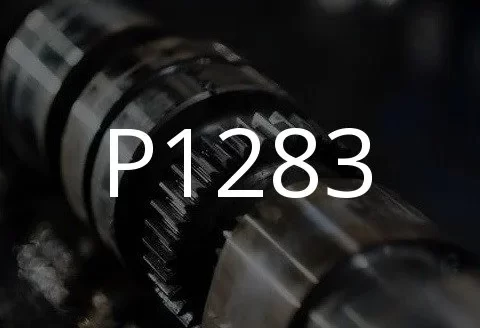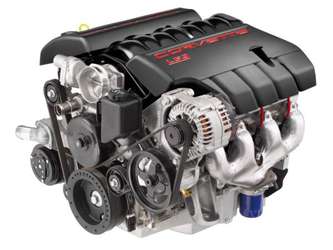
P1283 (Volkswagen, Audi, Skoda, Seat) Pneumatic injector control valve - electrical circuit malfunction
Content
P1283 – OBD-II Trouble Code Technical Description
Trouble code P1283 indicates a malfunction in the electrical circuit of the pneumatic injector control valve in Volkswagen, Audi, Skoda, and Seat vehicles.
What does the fault code mean P1283?
Trouble code P1283 indicates a possible problem with the injector air control valve electrical circuit. This valve is responsible for regulating the supply of fuel to the engine cylinders. When the system detects a fault in the electrical circuit of this valve, it can result in improper fuel delivery, which in turn can cause various engine performance problems. The valve's electrical circuit can be disrupted for a variety of reasons, including opens, shorts, poor connections, or damaged wiring. This may occur due to physical damage to the wires, corrosion of the connectors, or wear and tear of the electronic components.

Possible reasons
Trouble code P1283 can be caused by various reasons:
- Breaks or short circuits in the electrical circuit: Broken wires, shorts between wires or to ground, and other electrical problems in the circuit can cause the injector air control valve to not operate properly.
- Damage to connectors or connections: Corrosion, oxidation or damage to the connectors and connections between the wires and the valve can cause problems with electrical signal transmission.
- Worn or broken valve itself: The pneumatic injector control valve may become damaged or fail due to wear, manufacturing defects or other reasons, causing it to not operate properly.
- Engine controller problems: Malfunctions or errors in the operation of the engine controller can also lead to the P1283 code.
- Insufficient or excessive voltage in the circuit: Intermittent or incorrect power supply to the electrical circuit can also cause problems with the control valve.
- Mechanical damage or blockages: Physical damage or blockages in the valve mechanism may prevent it from operating properly.
To accurately determine the cause of the P1283 code, it is recommended to conduct a thorough diagnosis, including checking electrical connections, valve condition, engine controller operation and other relevant components.
What are the symptoms of a fault code? P1283?
Symptoms accompanying the P1283 code may include the following:
- Loss of engine power: Improper operation of the pneumatic injector control valve may result in insufficient fuel delivery to the engine cylinders, which may manifest itself as loss of power when accelerating or on rough roads.
- Unstable engine performance: An open circuit or malfunctioning valve can cause the engine to run rough, resulting in shuddering, revving, or rough idling.
- Difficulty starting the engine: Incorrect fuel supply may cause difficulty starting the engine or increase the number of attempts before starting successfully.
- Increased fuel consumption: Improper operation of the control valve may result in inefficient fuel combustion, which may result in increased fuel consumption.
- The appearance of errors on the instrument panel: If P1283 is detected, the Check Engine Light or other warning lights on your vehicle's dashboard may come on.
- Unstable idle: Incorrect operation of the injector valve can manifest itself in unstable engine operation at idle, with periodic changes in speed.
These symptoms may appear to varying degrees depending on the specific cause of the error and its effect on engine performance.
How to diagnose a fault code P1283?
To diagnose DTC P1283, you can follow these steps:
- Reading the error code: Use a diagnostic scan tool to read error codes from the engine control module memory. Verify that the P1283 code is indeed present.
- Checking stream data: After reading the error code, examine the flow data associated with fuel injection system operating parameters, such as fuel pressure, sensor readings, and control signals.
- Checking electrical connections: Carefully check the electrical connections and connectors associated with the pneumatic injector control valve. Look for corrosion, breaks, short circuits or poor connections.
- Checking the condition of the injector valve: Check the injector pneumatic control valve itself for physical damage, corrosion, or blockages. Make sure the valve moves freely and closes properly.
- Checking fuel pressure and injection system: Check the system fuel pressure and make sure it meets the manufacturer's specifications. You should also check the operation of other components of the fuel injection system.
- Checking the motor controller and software: If necessary, perform additional diagnostics on the motor controller and software to detect possible problems or errors.
After diagnosing and eliminating the cause of error P1283, it is recommended to test the vehicle on the road and clear the error code from the memory of the control module. If the problem persists, additional diagnostics or repairs may be required.
Diagnostic errors
When diagnosing DTC P1283, the following errors may occur:
- Limiting diagnostics to one component: The error can be caused by several factors, and focusing on only one component, such as electrical connections, may result in missing other possible causes of the error.
- Insufficient checking of electrical connections: Poor or faulty electrical connections can be the cause of the P1283 code, so you should carefully check all wires and connectors for corrosion, breaks, or poor connections.
- Misinterpretation of flow data: Misunderstanding of flow data or incorrect analysis of fuel injection system operating parameters may lead to incorrect conclusions and incorrect determination of the cause of the error.
- Ignoring other possible causes: Trouble code P1283 can be caused not only by problems with the valve's electrical circuit, but also by other factors such as faulty engine controller or mechanical problems. All possible causes must be taken into account.
- Component replacement failed: Replacing components without first diagnosing them or installing new parts incorrectly may not correct the problem and may result in additional repair costs.
To avoid these errors, it is recommended to carry out comprehensive diagnostics using specialized equipment and methods, as well as contact qualified specialists in the field of automotive service and repair.
How serious is the fault code? P1283?
Trouble code P1283 is serious because it indicates a potential problem with the injector air control valve electrical circuit. This valve plays an important role in regulating the flow of fuel to the engine cylinders. Improper operation of this valve can result in under- or over-fueling, which can cause serious problems with engine operation and performance.
Insufficient fuel supply can lead to loss of power, engine roughness, hard starting and other problems, while excess fuel supply can lead to increased fuel consumption, engine contamination and even damage to the catalyst.
In addition, the P1283 error code can also affect the vehicle's environmental performance, since improper combustion of fuel can lead to increased emissions of harmful substances into the atmosphere.
Overall, the P1283 trouble code requires immediate attention and diagnosis to eliminate the cause and prevent further damage to the engine or other vehicle systems.
What repair will help eliminate the code? P1283?
Resolving DTC P1283 will require the following:
- Checking and replacing electrical connections: Begin by thoroughly checking the electrical connections and connectors associated with the injector pneumatic control valve. Make sure connections are secure, free of corrosion or oxidation, and that wires are not broken or shorted. If necessary, replace damaged wires or connectors.
- Checking and replacing the pneumatic injector control valve: If the problem is not resolved by replacing the electrical connections, the pneumatic injector control valve itself should be inspected for damage, wear, or blockage. If the valve is faulty, it should be replaced with a new one.
- Motor controller diagnostics: Perform additional diagnostics on the motor controller to check its functionality and possible errors. If necessary, update the controller software or replace it.
- Checking other components of the fuel injection system: Check the condition and operation of other fuel injection system components such as fuel pressure sensors, fuel pump and injectors. Replace or repair faulty components as necessary.
- Checking for Mechanical Problems: Check for mechanical damage or blockages in the fuel injection system. Clean or replace clogged components.
After repairs, it is recommended to clear the error code from the memory of the control module and test the vehicle on the road to confirm serviceability. If the problem persists, additional diagnostics or repairs may be required.

